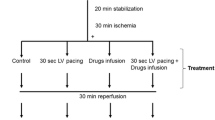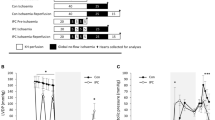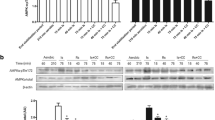Abstract
In this study incorporation of [3H]inositol into inositol phosphates and phosphoinositides as well as tissue Ins(1,4,5)P3 levels of the atria and ventricles of isolated, perfused rat hearts were compared. Although the incorporation of [3H]inositol into the phosphoinositides of atria and ventricles was similar, significantly higher (2–3 fold) incorporation rates into inositol phosphates were observed in atrial tissue. Using a D-myo-[3H]Ins(1,4,5)P3 assay system, the Ins(1,4,5)P3 levels observed in atria from perfused rat hearts were also significantly higher than those obtained under the same experimental circumstances in the ventricles.
Since previous studies on whole hearts showed inhibition of the phosphatidylinositol (PI) pathway during ischaemia with an immediate significant stimulation upon reperfusion [12, 20], the effects of ischaemia and 1 min postischaemic reperfusion were also examined separately in atria and ventricles. The results showed that 20 min of global ischaemia significantly depressed Ins(1,4,5)P3 levels as well as incorporation of [3H]inositol into ventricular InSP2 and InSP3. Reperfusion caused an immediate (within 1 min) increase in Ins(1,4,5)P3 levels and also [3H]inositol incorporation into all three cytosolic inositol phosphates in the ventricles. However, the effect of ischaemia and reperfusion on Ins(1,4,5)P3 levels as well as the incorporation of [3H]inositol into the inositol phosphates were less prominent in the atria. It therefore appears that the differential responses of the atria and the ventricles to an oxygen deficiency [41] are also reflected in the differences in PI metabolism during ischaemia-reperfusion.
Similar content being viewed by others
References
Michell RH: Inositol phospholipids in membrane function. TIBS 4: 128–131, 1979
Berridge MJ, Irvine RF: Inositol trisphosphate, a novel second messenger in cellular signal transduction. Nature 312: 315–321, 1984
Berridge MJ: Inositol trisphosphate and diacylglycerol: Two interacting second messengers. Ann Rev Biochem 56: 159–193, 1987
Berridge MJ, Irvine RF: Inositol phosphates and cell signalling. Nature 341: 197–205, 1989
Brown JH, Buxton IL, Brunton LL: Alpha1-adrenergic and muscarinic cholinergic stimulation of phosphoinositide hydrolysis in adult rat cardiomyocytes. Circ Res 57: 532–537, 1985
Renard D, Poggioli J: Does the inositol tris/tetrakisphosphate pathway exist in rat heart? FEBS Lett 217: 117–123, 1987
Schmitz W, Scholz H, Scholz J, Steinfath M: Increase in IP3 precedes alpha1-adrenoceptor-induced increase in force of contraction in cardiac muscle. Eur J Pharmacol 140: 109–111, 1987
Woodcock EA, Schmauk White LB, Smith AI, McLeod JK: Stimulation of phosphatidylinositol metabolism in the isolated, perfused rat heart. Circ Res 61: 625–631, 1987
Otani H, Otani H, Das DK: Alpha1-adrenoceptor-mediated phosphoinositide breakdown and inotropic response in rat left ventricular papillary muscles. Circ Res 62: 8–17, 1988
Meij JTA, Lamers JMJ: Alpha1-adrenergic stimulation of phosphoinositide breakdown in cultured neonatal rat ventricular myocytes. Mol Cell Biochem 88: 73–75, 1989
Kohl C, Schmitz W, Scholtz H, Scholtz J: Evidence for the existence of inositol tetrakisphosphate in mammalian heart. Circ Res 66: 580–583, 1990
Mouton R, Huisamen B, Lochner A: Increased myocardial Inositol trisphosphate levels during α1-adrenergic stimulation and reperfusion of ischaemic rat heart. Mol Cell Cardiol 23: 841–850, 1991
Vites AM, Pappano A: Inositol 1,4,5-trisphosphate releases intracellular Ca2+ in permeabilized chick atria. Am J Physiol 258: H1745-H1752, 1990
Sonnenberg H, Veress AT: Cellular mechanism of release of atrial natriuretic factor. Biochem Biophys Res Commun 124: 443–449, 1984
Currie MG, Newman WH: Evidence for alpha1-adrenergic receptor regulation of atriopeptin release from the isolated rat heart. Biochem Biophys Res Commun 137: 94–100, 1986
Doubell AF: The second messenger system(s) mediating the secretion of atrial natriuretic peptide (ANP) from the isolated rat heart during rapid cardiac pacing. Life Sciences 45: 2139–2200, 1989
Mantymaa P, Leppalnoto J, Ruskoaho H: Endothelin stimulates basal and stretch-induced atrial natriuretic peptide secretion from the perfused rat heart. Endocrinology 126: 587–595, 1990
Kuraja IJ, Woodcock EA: Endothelin stimulates inositol phosphate accumulation in rat right and left atria: A comparison with noradrenaline. Clin Exp Pharmacol Phys 17: 275–280, 1990
de Champlain J, Eid H, Papin D: Potentiated endothelin-1-induced phosphoinositide hydrolysis in atria and mesenteric artery of DOCA-salt hypertensive rats. J Hypertension Suppl 7(6): S136–5137, 1989
Mouton R, Huisamen B, Lochner A: The effect of ischaemia and reperfusion on sarcolemmal inositol phospholipid and cytosolic inositol phosphate metabolism in the isolated perfused rat heart. Mol Cell Biochem 105: 127–135, 1991
Bligh EG, Dyer WJ: A rapid method of total lipid extraction and purification. Can J Physiol 37: 911–917, 1959
Lowry AO, Rosenbrough NJ, Farr AL, Randall RJ: Protein with the folin phenol reagent. J Biol Chem 193: 265–275, 1951
Itaya K, Ui M: A new micromethod for the calorimetric determination of inorganic phosphate Clin Chim Acta 14: 361–366, 1966
Von Harsdorf R, Lang RE, Fullerton M, Woodcock EA: Myocardial stretch stimulates phosphatidylinositol turnover. Circ Res 65: 494–501, 1989
Kisch B: A significant electron microscopic difference between the atria and the ventricles of the mammalian heart. Exp Med Surg 21: 193–221, 1963
Koch-Wesser J, Blinks JR: The influence of the interval between beats on myocardial contractility. Pharmacol Rev 15: 601–652, 1963
Davies F, Francis ET, Stoner HB: The distribution of nucleotide, phosphocreatine and glycogen in the heart. J Physiol 106: 154–166, 1947
Dietz JR: Control of atrial natriuretic factor release from a rat heart-lung preparation. Am J Physiol 252: R498-R502, 1987
Schiebinger RJ, Linden J: The influence of resting tension on immunoreactive atrial natriuretic peptide secretion by rat atria superfused in vitro. Circ Res 59: 105–109, 1986
Ruskoaho H, Kinnunen P, Taskinen T, Vuolteenaho O, Leppaltuoto J, Takala TES: Regulation of ventricular atrial natriuretic peptide release in hypertrophied rat myocardium. Effects of exercise. Circulation 80: 390–400, 1989
Opie LH: Ventricular overload and heart failure. In: LH Opie (ed.) The Heart 2nd Ed. Raven Press, New York, 1991, 396–424
Fukada Y, Hirata Y, Taketani S, Kojima T, Oikawa S, Nakazato H, Kobayashi Y: Endothelin stimulates accumulations of cellular atrial natriuretic peptide and its messenger RNA in rat cardiocytes. Biochem Biophys Res Commun 164: 1431–1436, 1989
Hu JR, Berninger UG, Lang RE: Endothelin stimulates atrial natriuretic peptide (ANP) release from rat atria. Eur J Pharmacol 158: 177–178, 1988
Volpe M, Atlas SA, Sosa RE, Marion DE, Mueller FB, Sealy JE, Laragh JH: Angiotensin II-induced atrial natriuretic factor release in dogs is not related to hemodynamic response. Circ Res 67: 774–779, 1990
Baker KM, Singer HA: Identification and characterization of guinea pig angiotensin 11 ventricular and atrial receptors: Coupling to inositol phosphate productions. Circ Res 62: 896–904, 1988
Matsubara H, Hirata Y, Yoshimi H, Takata S, Takagi Y, Umeda Y, Yamane Y, Inada M: Role of calcium and protein kinase C in ANP secretion by cultured rat cadiocytes. Am J Physiol 255: H405-H409, 1988
Ruskoaho H, Toth M, Ganten D, Unger TH, Lang RE: The phorbol ester induced atrial natriuretic peptide secretion is stimulated by forskolin and Bay K8644 and inhibited by 8-bromocyclic GMP. Biochem Biophys Res Commun 138: 266–274, 1986
Quist E, Satumtira N, Powell P: Regulation of polyphosphoinositide synthesis in cardiac muscle. Arch Biochem Biophys 271: 21–32, 1989
Schwertz DW, Halverson J, Isaacson T, Feinberg H, Palmer JW: Alterations in phospholipid metabolism in the globally ischemic rat heart: Emphasis on phosphoinositide specific phospholipase C activity. J Mol Cell Cardiol 19: 685–697, 1987
Kasinathan C, Xu ZC, Kirchberger MA: Polyphoshoinositide formation in the isolated cardiac plasma membranes. Lipids 24: 818–823, 1989
McDonald TF, Macleod DP: Anoxic atrial and ventricular muscle electrical acitivity, cell potassium, and metabolism: A comparative study. J Mol Cell Cardiol 5: 149–159, 1973
Sheridan DJ, Penkoske PA, Sobel BE, Corr PB: Alpha adrenergic contributions to dysrhythmia during myocardial ischemia and reperfusion in cats. J Clin Invest 65: 161–171, 1980
Corr PB, Shayman JA, Kramer JB: Increased alpha1-adrenergic receptors in ischemic cat myocardium. J Clin Invest 67: 1232–1236, 1981
Schömig A, Dart AM, Dietz R, Mayer E, Kubler W: Release of endogenous cathecolamines in the ischemic myocardium of the rat. Part A: Locally mediated release. Circ Res 55: 689–701, 1984
Edoute Y, Van der Merwe E, Sanan D, Kotze JCN, Steinmann C, Lochner A: Normothermic ischaemic cardiac arrest of the isolated working rat heart. Effects of time and reperfusion on myocardial ultrastructure, mitochondrial oxidative function, and mechanical recovery. Circ Res 53: 663–768, 1983
Author information
Authors and Affiliations
Rights and permissions
About this article
Cite this article
Mouton, R., Genade, S., Huisamen, B. et al. The effect of ischaemia-reperfusion on [3H]inositol phosphates and Ins(1,4,5)P3 levels in cardiac atria and ventricles — a comparative study. Mol Cell Biochem 115, 195–202 (1992). https://doi.org/10.1007/BF00230331
Received:
Accepted:
Issue Date:
DOI: https://doi.org/10.1007/BF00230331




